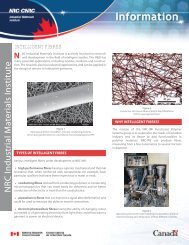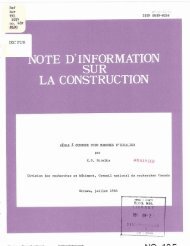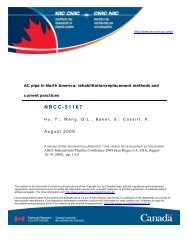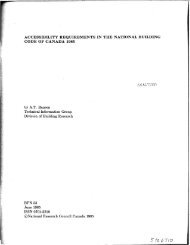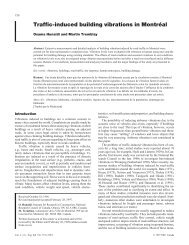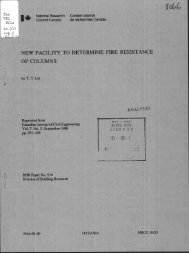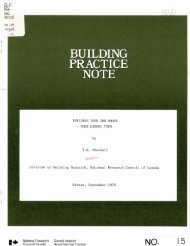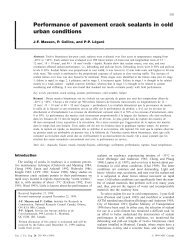Effect of Automatic Sprinkler Protection on Smoke Control Systems
Effect of Automatic Sprinkler Protection on Smoke Control Systems
Effect of Automatic Sprinkler Protection on Smoke Control Systems
Create successful ePaper yourself
Turn your PDF publications into a flip-book with our unique Google optimized e-Paper software.
smoke from the building. Studies such as these c<strong>on</strong>tributeto a quantitative understanding <str<strong>on</strong>g>of</str<strong>on</strong>g> the interacti<strong>on</strong> betweensprinklers and the buoyant layer. They are theoretical,however, and most have not yet been validated by full-scaletesting.In the absence <str<strong>on</strong>g>of</str<strong>on</strong>g> full-scale test data <strong>on</strong> the maximumfire size to be expected in a sprinklered <str<strong>on</strong>g>of</str<strong>on</strong>g>fice building,Morgan and Hansell (1985) c<strong>on</strong>ducted a review <str<strong>on</strong>g>of</str<strong>on</strong>g> Britishfire loss statisticsc Their objective was to identify' a "designfire" size for use in designing smoke ventilati<strong>on</strong> systems foratria in sprinklered and unsprinklered buildings. Theirreview indicated that the maximum heat release rates andareas <str<strong>on</strong>g>of</str<strong>on</strong>g> fire involvement in sprinklered buildings weremuch lower than in unsprinklered buildings. Fires insprinklered buildings were estimated to have attained heatrelease rates between 285 and 2,850 Btu/s (300 and 3,000kW) before being extinguished by the sprinklers, with theprobability <str<strong>on</strong>g>of</str<strong>on</strong>g> occurrence <str<strong>on</strong>g>of</str<strong>on</strong>g> smaller fires much higher thanfor larger fires. This study supported the British designpractice for smoke c<strong>on</strong>trpl systems <str<strong>on</strong>g>of</str<strong>on</strong>g> assuming a 5-MWdesign fire under sprinklered c<strong>on</strong>diti<strong>on</strong>s, with an area <str<strong>on</strong>g>of</str<strong>on</strong>g> 10n:Jl. Morgan and Hansell's informati<strong>on</strong> is a useful startingpoint for examining the questi<strong>on</strong> regarding the likelihood <str<strong>on</strong>g>of</str<strong>on</strong>g>occurrence and size <str<strong>on</strong>g>of</str<strong>on</strong>g> shielded fires in sprinklered buildings.Gustafss<strong>on</strong> (1989), Heskestad (1974), Hinkley (1989),and Battrick (1986) report <strong>on</strong> the l<strong>on</strong>g-standing c<strong>on</strong>troversybetween sprinkler and ventilati<strong>on</strong> experts about whether ornot ventilati<strong>on</strong> <str<strong>on</strong>g>of</str<strong>on</strong>g> hot gases from a sprinklered buildingthrough ro<str<strong>on</strong>g>of</str<strong>on</strong>g> Vel)tS during a fire is beneficial to the c<strong>on</strong>trol<str<strong>on</strong>g>of</str<strong>on</strong>g> the fire. <str<strong>on</strong>g>Sprinkler</str<strong>on</strong>g> experts argue that automatic smokevents detract from proper performance <str<strong>on</strong>g>of</str<strong>on</strong>g> the sprinklersystem. <strong>Smoke</strong> ventilati<strong>on</strong> specialists, in tum, argue thatreduced smoke logging <str<strong>on</strong>g>of</str<strong>on</strong>g> the building improves interiorfirefighting and reduces smoke damage. Although somefull-scale studies have been d<strong>on</strong>e (Gustafss<strong>on</strong> 1989), theyare usually based <strong>on</strong> either a <strong>on</strong>e-story warehouse buildn1gor a shopping mall, with ro<str<strong>on</strong>g>of</str<strong>on</strong>g> vents, and are therefore notimmediately useful for analyzing the impact <str<strong>on</strong>g>of</str<strong>on</strong>g> sprinklers <strong>on</strong>an operating z<strong>on</strong>ed smoke c<strong>on</strong>trol system in a high-risebuilding.Two notable excepti<strong>on</strong>s to the shortage <str<strong>on</strong>g>of</str<strong>on</strong>g> full-scaleexperimental work involving sprinklers and smoke c<strong>on</strong>trolmeasures are studies c<strong>on</strong>ducted by the Seattle Fire Depart- .ment in an <str<strong>on</strong>g>of</str<strong>on</strong>g>fice building (Seattle FD 1984) and by Kloteat a hotel in Washingt<strong>on</strong>, DC (Klote 1990). The Seattlework looked at fire pressures generated by sprinklered andunsprinklered fires; carb<strong>on</strong> m<strong>on</strong>oxide generated by sprinklered,shielded fires; and the performance <str<strong>on</strong>g>of</str<strong>on</strong>g> three smokec<strong>on</strong>trol approaches: stairwell· pressurizati<strong>on</strong>, elevator shaftpressurizati<strong>on</strong>, and z<strong>on</strong>ed smoke c<strong>on</strong>trol. The Seattle studyc<strong>on</strong>cluded that sprinklers were indeed effective in reducingfire pressures and thereby improved the likelihood thatsmoke c<strong>on</strong>trol systems designed to current standards (forassumed n<strong>on</strong>sprinklered c<strong>on</strong>diti<strong>on</strong>s) would prevent smokespread. There was no suggesti<strong>on</strong> that design standards couldbe reduced for sprinklered fire c<strong>on</strong>diti<strong>on</strong>s. Problems <str<strong>on</strong>g>of</str<strong>on</strong>g> lossASH RAE Transacti<strong>on</strong>s: Research<str<strong>on</strong>g>of</str<strong>on</strong>g> stair pressurizati<strong>on</strong> <strong>on</strong> opening <str<strong>on</strong>g>of</str<strong>on</strong>g> doors, with subsequentc<strong>on</strong>taminati<strong>on</strong> <str<strong>on</strong>g>of</str<strong>on</strong>g> the stairshafts, were noted. The resultsprovide a useful starting point for further validating studies.Klote (1990) studied n<strong>on</strong>sprinklered fires with smokec<strong>on</strong>trol and sprinklered · filllS without smoke c<strong>on</strong>trol in aseries <str<strong>on</strong>g>of</str<strong>on</strong>g> full-scale tests in a h9tel in Washingt<strong>on</strong>, DC,which was destined to be demolished. He noted that firepressures were very low in the sprinklered fires and wouldnot likely pose a challenge for a smoke c<strong>on</strong>trol systemdesigned to meet current standards (Klote and Milke 1992;NFPA 1988). Klote (1990) noted that more tests would berequired, however, to determine how operati<strong>on</strong> <str<strong>on</strong>g>of</str<strong>on</strong>g> thesmoke c<strong>on</strong>trol system in the sprinklered fires would havechanged smoke spread bey<strong>on</strong>d the fire floor. He also notedthat, for sprinklered fires that are not rapidly extinguished,smoke producti<strong>on</strong> could be significant and smoke c<strong>on</strong>trolcould be useful.The ability <str<strong>on</strong>g>of</str<strong>on</strong>g> sprinkler systems to c<strong>on</strong>trol and extitiguishunshielded fires is well established (Richards<strong>on</strong> 1983;Walt<strong>on</strong> 1988; Madrzykowski and Vettori 1992). In resp<strong>on</strong>seto Klote's c<strong>on</strong>cerns about shielded fires, however, it wasdecided to pay particular attenti<strong>on</strong> to fires that could not beextinguished immediately by· the sprinklers and that wouldresult in sustained smoke producti<strong>on</strong> under cool c<strong>on</strong>diti<strong>on</strong>s.On the basis <str<strong>on</strong>g>of</str<strong>on</strong>g> Klote' s suggesti<strong>on</strong>s for further research, theTechnical Committee (TC 5.6) <strong>on</strong> Fire and <strong>Smoke</strong> C<strong>on</strong>trol<str<strong>on</strong>g>of</str<strong>on</strong>g> the American Society <str<strong>on</strong>g>of</str<strong>on</strong>g> Heating; Refrigerating and AirC<strong>on</strong>diti<strong>on</strong>ing Engineers, Inc. (ASHRAE), agreed to providefunds for research to investigate the effects <str<strong>on</strong>g>of</str<strong>on</strong>g> sprinklers <strong>on</strong>the performance <str<strong>on</strong>g>of</str<strong>on</strong>g> a z<strong>on</strong>ed smoke c<strong>on</strong>trol system. TheNati<strong>on</strong>al Fire Laboratory <str<strong>on</strong>g>of</str<strong>on</strong>g> the Institute for Research inC<strong>on</strong>structi<strong>on</strong> at the Nati<strong>on</strong>al ReSearch Council <str<strong>on</strong>g>of</str<strong>on</strong>g> Canadaalso fu~ded the project.EXPERIMENT DESCRIPTIONA series <str<strong>on</strong>g>of</str<strong>on</strong>g> experiments involving shielded, sprinkleredfires was c<strong>on</strong>ducted at. the Nati<strong>on</strong>al Fire Laboratory's fullscalefire test facility located near Ottawa, Canada. Thefacility c<strong>on</strong>sists <str<strong>on</strong>g>of</str<strong>on</strong>g> a very large Bum Hall, in which a <strong>on</strong>estoryfire test room· was c<strong>on</strong>structed, and a 10-storyexperimental tower (referred to as the Tower). Both theTower and the <strong>on</strong>e-story test room were used to carry outthe testing for this project.One-Story Test RoomA <strong>on</strong>e-story fire test room (Figure 1) was c<strong>on</strong>structedinside the Bum Hall, equipped with sprinklers and instrumentedwit!t pressure, temperature, and gas analysis equipment.A products-<str<strong>on</strong>g>of</str<strong>on</strong>g>-combusti<strong>on</strong> collector attached to thetest room allowed oxygen calorimetry to be used to measurethe heat release rates <str<strong>on</strong>g>of</str<strong>on</strong>g> sprinklered fires. The roommeasured 20ft by 20 ft by 12ft (6.1 m by 6.1 m by 3.6 m)with an a!tached corridor that was 20 ft l<strong>on</strong>g by 8 ft wideby 12ft high (6.1 m by 2.4 m by 3.6 m) <strong>on</strong> <strong>on</strong>e side. Thecorridor could be pressurized independently <str<strong>on</strong>g>of</str<strong>on</strong>g> the test room495




